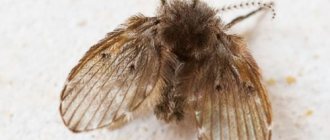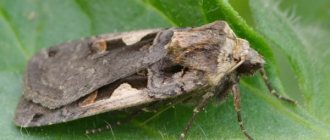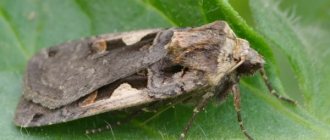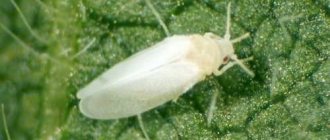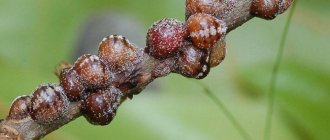Description of the pest
This parasite is a harmful insect with a transparent oval-shaped body. Its length is no more than 1 mm, but on average this figure is 2 times less. In the larval stage, it is distinguished by a light green color and belongs to the Arachnida class. It is extremely difficult to detect it only with the help of a magnifying glass.
Adult individuals are already distinguished by a bright red color. Since the pest is omnivorous, absolutely all ornamental crops fall into the attack group. It can quite normally be in warm conditions with high levels of humidity; it is not afraid of low temperatures. As a result of the active life of the insect, the rose becomes depleted and dies due to loss of nutrients.
Fungal diseases
Powdery mildew
With this disease, the flower quickly loses its properties. Pathogen: Erysiphales fungus. First, the leaf plates are covered with a whitish coating, similar to flour. The spores resemble white drops of dew scattered on the surface. Infected leaves, buds, and branches stop growing. The leaves darken and begin to fall off.
Popular: Three ways to effectively control ragweed
Powdery mildew develops best in a room with a temperature above 20 degrees or with sudden changes in air humidity. Excessive “overfeeding” of fertilizers also leads to fungal infection. Spores can easily be introduced with water through contact with other flowers on the windowsill.
To reduce the risk of fungal infection, the grower must monitor the amount of nitrogen compounds that are used to fertilize the plant. They are not watered at the end of summer. The bush should not be thickened, so the plant is further thinned out in the spring months and autumn. Compositions with potassium improve immune protection. They water the bush from mid-summer. Before flowering, treatment with Fundazol and Topsin M is recommended. The plant is treated for a fungal infection using the drug “Skor”.
Peronospora fungus
The disease has another pathogen. This is a Peronospora fungus. Downy mildew occurs when the soil in the pot is waterlogged or the room is too humid. Therefore, indoor roses should not be flooded. The pathogen begins to develop sharply if the room is humid and there is not enough light, the room is not ventilated. The fungal infection prefers to infect bushes with low immunity and mechanical microtraumas. Downy mildew develops not only on roses, but also on bushes of berry and fruit crops.
First, brown, red spots appear on the leaves. The back side of the plate is covered with a film of plaque. Later, the stems crack, ready to bloom, and the buds become dark. When a fungal infection develops, unopened flowers simply die.
To prevent downy mildew, gardeners use watering with a solution of copper sulfate. The first time it is watered in early spring, then after the bush blooms and the leaves fall. For preventive measures, you can also use the drugs “Kuprozan”, “Ditanom - M 45”.
For treatment, a solution of copper sulfate is also used, but in a higher concentration than for prevention (at the rate of 100 grams of the substance per bucket of water). If the bush is infected, then it is better to destroy the rose so that the fungus does not infect other plants. If it is partially affected by downy mildew, then it is better to remove the infected areas with scissors or cut with a knife.
All instruments must be treated with formaldehyde solution at a concentration of 1%. Treatment with Strobi and timely application of fertilizers with potassium and phosphorus will help to cope with fungal disease.
Black spot
This is another fungal disease that affects indoor roses. The disease begins with infection of buds and leaves. Black dots appear on the leaf blades. As they develop, they become brown or black spots. At the same time, inside them there is a light center, and their edges are dark. Over time, the leaf plate begins to deform and curl up. The bush quickly loses its appearance and begins to weaken. The rose slows down its growth.
Typically, black spotting develops due to indoor humidity and improper watering. It provokes a fungal infection and a large amount of nitrogen fertilizers, low temperature in the room. Black spotting can be introduced onto a houseplant by watering. Possible insect infestation. Treatment in the spring with a solution of copper sulfate in a concentration of 10 to 15 grams per bucket of water eliminates spores.
Popular: Measures to combat powdery mildew on roses
In the autumn months, the rose can be treated for prevention with a three percent solution of copper sulfate. First, all affected parts of the bush are removed and burned. To treat black spotting, it is necessary to use products with copper and zinc. In the store you can buy drugs “Kaptan”, “Fundazol”. They are also used to treat other indoor plants.
Gray rot
Roses are often infected with gray mold, which is caused by Botrytis cinerea. The disease develops from the stem and gradually moves upward. If left untreated, the fungal infection will quickly affect the entire bush. Dark yellow spots appear on the stems. Then inclusions develop on the buds and leaf blades. The fungus appears when there is constant humidity in the room or a change in temperature. If all this is accompanied by rare ventilation of the room and there is still little light for the flower, then gray rot occurs very often.
The pathogen develops in dying tissues and is capable of infecting almost all crops. The grower should sometimes carry out infection prevention. The pathogen remains in the soil of the pot for a long time and at any favorable moment the infection begins to develop. Therefore, the soil in the pot should be regularly loosened and old or diseased shoots of indoor roses should be eliminated. To prevent the disease, spraying with a solution of copper sulfate is used. Fungal disease is treated with Fundazol.
Rust
The causative agent of the disease Uredinales is activated by high humidity in the room and improper watering. The fungus develops from pustules that contain spores. They burst and spread through the air, infecting rose bushes. The leaves of the plant darken and begin to fly off. Orange spots develop on the leaf blades.
The leaves begin to curl and themselves serve as carriers of infection. To prevent rust, the affected areas are cut off. In autumn, the bush is treated with Bordeaux mixture and immunostimulants. Spraying with Topaz or Bayleton will help cure the fungus.
Reasons for appearance
Among the factors contributing to the appearance of a dangerous insect on a home rose, experienced gardeners identify:
- Dry and warm air in the room. This climate is a favorable environment for the parasite to reproduce.
- Serious mistakes in flower care. If you do not provide your green pet with sufficient moisture during the active growing season, then it becomes very vulnerable and can easily be affected by harmful insects and diseases.
- Using contaminated soil when planting. If ordinary garden soil is used to fill the pot, which is not disinfected at home, then you can easily bring in uninvited guests with it.
The pest often enters an apartment through an open window, pet hair, or donated flowers purchased at a specialized retail outlet.
Signs of an affected plant
It is possible to identify a plant that is infected by the following signs:
- the appearance of small black dots on the leaf blades (traces from the proboscis of the larvae);
- change in natural color to yellow;
- leaves rolled into a tube;
- slow growth and development of the bush;
- numerous webs;
- massive loss of leaves;
- reduction in the size of buds;
- affected by fungal diseases;
- painful condition.
Consequences of infection
If you don’t know how to get rid of spider mites on roses, then there is a high probability of losing the flower. Treatment should begin at the first sign of detection of the parasite. Among the consequences that will appear in the absence of spraying with chemicals or folk remedies are:
- Destruction of cells leading to deterioration of the process of photosynthesis. The result is a weakening of the flower.
- Loss of decorativeness. Green leaves quickly turn yellow, dry out, and the buds become smaller.
- The appearance of gray rot or other fungal disease. The pest is a common cause of the development of this disease. Since the insect feeds on the cell sap of the plant, its immunity decreases and the degree of susceptibility to parasitic individuals increases.
The sooner you start treating a rose affected by spider mites, the greater the chance of helping it recover quickly.
Prevention
Preventing the appearance of spider mites on roses is much easier than dealing with their invasion afterwards. Preventive measures are extremely simple:
- regularly check the lower surface of the leaves and, before using any drugs, make sure that you are dealing with spider mites;
- each new specimen should remain in quarantine for a couple of weeks - away from your greenhouse, and only after that, if no signs of infection are found on the flower, it can be placed next to other plants;
- try to maintain optimal soil and air humidity - such conditions are unattractive for spider mites, and even if several pests do appear, the humidity will prevent their active reproduction;
- in addition to roses, spider mites are very fond of orchids, and this circumstance must be taken into account when arranging plants;
- remove fallen leaves in a timely manner and do not allow them to accumulate under the bushes;
- for preventative purposes, it is good to use the same soap solution, only in this case they should regularly wipe the window sills and shelves on which the plants are located, as well as the trays and the pots themselves.
By following all the rules described above, you can protect your roses from spider mite infection and enjoy the healthy appearance of your charming “pets” every day.
Chemicals to combat spider mites
In an advanced stage, when the number of parasite colonies is large, roses cannot be saved without highly effective remedies against spider mites. To ensure that the parasite is removed from the bushes, the following agrochemicals must be used for leaf spraying:
- Actellik. This enteric-contact drug is capable of destroying insects at any stage of its development; it effectively fights eggs, larvae and adults. It is necessary to treat affected roses 2 times with an interval of 7 days. You need to spray flowers not indoors, but outdoors, since the drug is toxic. Prepare a working fluid at the rate of 2 ml of product per 1 liter of water. Spraying is carried out especially carefully on the underside of the leaves.
- Apollo. The drug kills the pest at the egg, larvae and nymph stages, and sterilizes mature individuals, preventing them from reproducing. Thanks to the active ingredient – clofentezine, indoor crops are reliably protected from insects for 2-3 months. The number of treatments is 2 times. Dilute the product using one ampoule per 5 liters of water.
- Floromite. The action of the drug is based on the performance characteristics of its active component - biphenazate. It suppresses the vital activity of the pest in its active phase, the effectiveness of the working solution begins to appear within 2 hours after use. The full result is achieved after 3-4 days and lasts for 3 weeks. Sick roses are treated twice, with an interval of 7 days, using a solution of 2 ml of the drug and 5 liters of water.
- Fitoverm. An insectoacaricide of biological origin refers to drugs with enteric contact action. It is allowed to be used indoors and in closed spaces. Roses are sprayed 3-4 times with an interval of 7 days. Prepare a solution at the rate of 2.5 ml per 1.25 liters of water.
You should not use broad-spectrum products too often, otherwise, instead of benefiting, the rose will suffer even more harm. Due to the high concentration of nitrogen on the surface of the plates, which appears during repeated treatments, the conditions for existence and reproduction only improve for the harmful insect.
The result of the activity of a spider mite
Spider mite on an apple tree
If the number of spider mites is small, then it does not cause much harm to the rose. However, under favorable conditions, the colony of mites quickly grows and harms the plant. Larvae and adults, having bitten through the leaf, feed on plant juices, as a result the plant begins to wither. Black spots appear on the leaves, the foliage turns yellow, dries and falls off.
Important! Spider mites have a particularly detrimental effect on young plants. On affected rose bushes in a dry climate and insufficient humidity, healthy buds simply will not form.
Additional measures to combat ticks
The success of manipulations against the pest depends on the stage of infection and its number. First of all, you need to inspect the flower to identify the insect. If it is detected, rinse the bush with warm water and wipe the leaves with a weakly concentrated alcohol solution.
When the plant dries out from water treatments, it should be sprayed with an appropriate chemical or folk remedy. The window sill and all objects next to the pot also need to be treated. After a week, it is necessary to reuse the working solution and add fertilizer with potassium to increase the plant’s defenses.
Preventive actions
In order not to treat roses from uninvited guests, you must adhere to the following recommendations:
- carry out regular ventilation of the lower leaf plates;
- a new purchase from the store should be quarantined in another room for several days;
- comfortable conditions for the flower should be maintained in the room;
- do not place roses near orchids;
- fallen leaves must be removed in a timely manner;
- Wash window sills regularly with soapy water.
Indoor plants can fill the air with oxygen, create a pleasant atmosphere in the room, and add zest to the interior, but they are in great need of proper care. If there are serious errors, then flower crops begin to get sick, wither, and may die. To help an affected rose, you need to know how to treat it against spider mites. There are many ways to combat it: both chemical and folk. The main thing is to follow the instructions for use, carry out treatments at the first sign of an insect appearing in the house, and do not forget about prevention.
Folk remedies
The consequences of using chemical solutions can be disastrous for new seedlings.
If the spider mite was detected in time, the following will help get rid of it:
- Washing with any soap, most often using laundry or tar soap. All parts of the flower, except the buds, should be treated with soap foam and left for a while. After this, the plant is washed with clean water and covered with cellophane for 1-2 hours to limit the access of oxygen.
- Brewed garlic. 150 g of crushed cloves are poured into 2 liters of hot water and infused in a dark place for 5-7 days. Then the tincture is filtered, diluted 1:2 with water and used to spray the leaves and buds of a rose or other plant.
- Brewed onion skins. 25 g of husk is poured into 1 liter of boiling water, the infusion is prepared within a week. The finished product can be used to treat all parts of the plant.
- Tobacco. 100 g of powder tobacco is mixed with 2 liters of liquid, then the resulting mixture is left for 1-2 days. After preparation, the solution is filtered and used to treat flowers once every 3-4 days.
Traditional methods of treatment can be combined with the use of drugs. Taken together, these control measures will lead to quick and long-term results.



